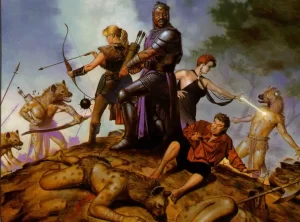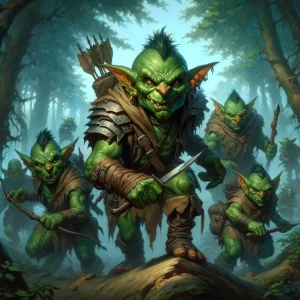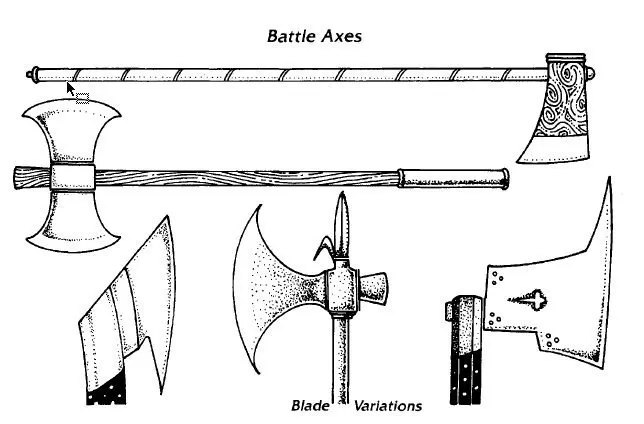
One of the most common events in the life of an adventurer, regardless of profession, is the need for armed combat. Some adventurers make a career of hacking and slashing, while others use combat as a last resort, after diplomacy, negotiation, or spell craft fail. Fortunately for adventurers, there are as many different types of weapons as there are reasons for using them.
Below are details the vast majority of weapons available to the discerning adventurer. A fair warning, though: a weapon is only as effective as the hero who wields it. Sometimes, a smaller, less lethal-looking weapon may be called for. Most of the entries that follow include commentary from distinguished adventurers. Heed their advice, look over the list carefully, and choose well; your character's life may depend on it!
Battle Axe
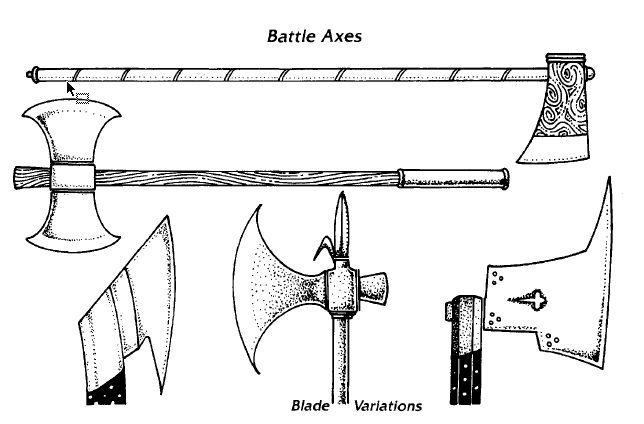
Contrary to popular artwork, the most common version of the battle axe is a stout pole about four feet in length with a single edged, trumpet-shaped blade mounted on one end. Battle axes are also called broad axes. The battle axe is a footman's weapon, giving these soldiers a longer reach and a fighting chance against mounted opponents. Its long handle allows the wielder to put considerable force into his swing. Despite the shaft length, a battle axe is a one-handed weapon.
The typical dwarven battle axe is a double-bladed weapon, usually with a spiked top. Dwarves favor these weapons since the long handles compensate somewhat for the shorter dwarven stature, especially against large humanoid opponents. They are often wielded with two hands. In many dwarven cultures, the battle axe is a symbol of dwarven might. A thrust with the spiked head of a battle axe inflicts ld3 hit points of damage. Dwarves are not the only race that favors the battle axe. Gnolls often are encountered with battle axes. Troglodytes use a stone version of the battle axe, with all of the disadvantages of stone weapons (i.e., prone to chipping and shattering). Two-handed battle axes have the same statistics as the bardiche. They are called "great axes."
"Though the battle axe is a one-handed weapon, its longer handle, which gives it good momentum, is not a good horseman's weapon, as the wielder has to put a lot of his weight into the swing, something hard to do from a saddle. It is also useless as a missile weapon. Still, its damage is respectable, and it looks nasty, especially the dwarven styles. A battle axe is good for the foot soldier or adventurer who needs to strike at a large creature or at someone on horseback. "Battle axes are good for their percussive and cutting effects against armor.
If adventurers want to use a battle axe and still gain some measure of protection, it is wise to fight alongside a companion who is armed with a sword and shield. The companion acts as the axe-wielder's defense while the latter is busy chopping away. This is a good exercise in teamwork, which may keep both adventurers alive much longer. "As for dwarves, our center of gravity is low enough that we can swing a battle axe and not topple over from the momentum. It is a fine weapon for hewing the legs of a giant out from under him, and it is a weapon that lets us put all of our weight into the swing."
Dagalor Goldenbeard of the Dwarven Clan Goldenbeard
The battle axe has the distinction of being one of the oldest tools and weapons of man. The first battle axe dates back about 35,000 years, when weaponeers began attaching the blade to long wooden handles. The double-bladed battle axe was born in Egypt during the Bronze Age, but the design did not gain widespread acceptance. During the Greco-Roman times, the battle axe was seen as a barbarian weapon used by the Franks, Celts, Lombards, and Vikings. The earliest modern battle axes were a Danish weapon of the ninth century.
These weapons did not have double-bladed heads but were still two-handed weapons. The Danes often decorated these axe heads with carvings. Some shafts reached six feet in length, which caused great structural strain on the point immediately below the axe-head. English knights of the 14th century adopted the battle axe as a favored weapon in foot combat. Its long handle afforded a great reach and allowed for a great amount of force to be focused on the blow. Naval crews used battle axes as boarding weapons until the tactic of boarding parties became obsolete. The dwarven battle axe design is based on an actual design by the Swiss, who called their version the mordaxt (fencing polearm).
Blowgun
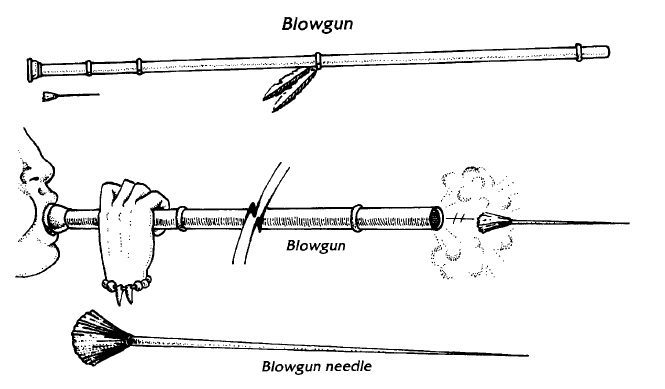
Blowguns are long, hollow tubes composed of wood or metal, ranging from four to seven feet in length. They are used to fire darts, needles, and pellets. The weapons date back to primitive times, when they were used mostly for hunting. Blowguns may have had a part in the invention of guns, since the blowgun demonstrated that one end of a tube needs to be closed off in order for the propelling force to shoot the missile in the proper direction. Tribes still exist, especially primitive peoples in tropical jungle cultures, that use the blowgun. In most cases, these tribes are not advanced in terms of inventions, especially weapons of war. Some tribes use stands to brace their blowguns. If a stand is used, the firer gains a + 1 bonus to his attack rolls. The grippli have been known to use blowguns on rare occasions.
"Though the blowgun has poor range, it is a quiet weapon which may be fired twice per round. Desperate adventurers who find themselves weaponless may make blowguns out of the local flora, such as reeds, if they are resourceful. Blowguns can also be used as makeshift breathing tubes if adventurers are crossing or hiding in a body if water. Being virtually noiseless, the blowgun is a good weapon for use in infiltrating a stronghold. Darts dipped in a sleep drug may knock out sentries quickly, and this may be an ideal arrangement for someone who wishes to avoid causing excessive bloodshed. It is certainly better suited for that sort of work than combat on the field, since the blowgun is a very fragile weapon."
Cedric D'Abalone, Sage
Blowgun Darts: The blowgun dart is a small arrow with a wad of cotton or other plant fibers instead of fletching. This allows for a build-up of pressure from the user's wind. The fibers make a better seal in the tube, allowing more force to gather behind it. A blowgun dart is not the same as a regular dart, and the latter cannot be shot out of a blowgun.
Needles: Needles are sometimes used to deliver a poison, often a paralytic poison such as curare. Needles do less damage than other blowgun missiles, but this is not a disadvantage, since their function is to carry the poison to the target, not to cause damage.
Blowgun Pellets: Most blowgun pellets are of hardened clay and are used for hunting. A solid hit from a pellet can stun a small bird.
Bola (also known as a Bolo)
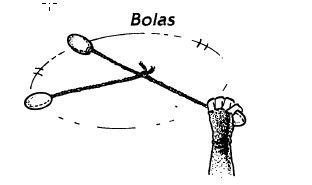
The bola is a missile of prehistoric origins. Currently, it is still used by arctic tribes and by savages who dwell on temperate plains. The main function of the bola is to provide a hunter with a good missile weapon that will catch the prey off guard and entangle it so as to make escape impossible. The bola is basically a leather strap or straps with weights fastened to the ends, although there are many variations to the design. Arctic bolas are generally used for hunting birds. The bola may have four, six, or ten weights made of walrus ivory or bone.
The weights are egg-shaped, spherical, or carved into the likeness of animals. All of the straps or cords join together to make a sort of handle. The thrower grasps the handle, jerks back the strand to straighten them, whirls the bolas over his head, and releases them. Each bola strand is about 28 inches long and each weight is about two inches in diameter.
Two-ball bolas are called somais; tripleball bolas are achicos. Temperate plains bolas are usually twice as large and consist of a single leather thong with a leather-covered stone at each end. Often a second cord is fastened in the center of the first cord, with a small weight attached at the end. This weight is held by the thrower. This version of the bola can bring down a man-sized target. When a bola hits, the victim is held fast and must take a round to make a
Strength check in order to get free. Failure means the bolas are still holding fast. If an attacker makes a Called Shot to the target's legs and succeeds, the bolas wrap themselves tightly around the victim's legs and prevent further movement. The target must make a Dexterity check in order not to fall down, incurring a - 3 penalty if the victim was moving when the bolas hit. If the attacker succeeds in a Called Shot to the victim's arms, the bolas wrap themselves tightly around the torso, preventing the victim from using a weapon or employing the protection of his shield until he frees himself.
Strength checks are made at - 2 penalty due to lack of leverage. A successful Called Shot to the victim's head wraps the bolas around his neck, strangling him (unless the character is wearing a great helm or closed-face helm). The bolas cause normal damage on the round in which they hit, then an additional ld3 hit points of strangulation damage every round the bolas are still in place.
"This is a good weapon to trip someone up, in case ya wanna take an opponent alive. But ya gotta make sure ya got enough room to give the bola a good swing. Bolas only work outside or in huge rooms. They work good if yer on horseback."
Barkhan, Bounty Hunter
Bows
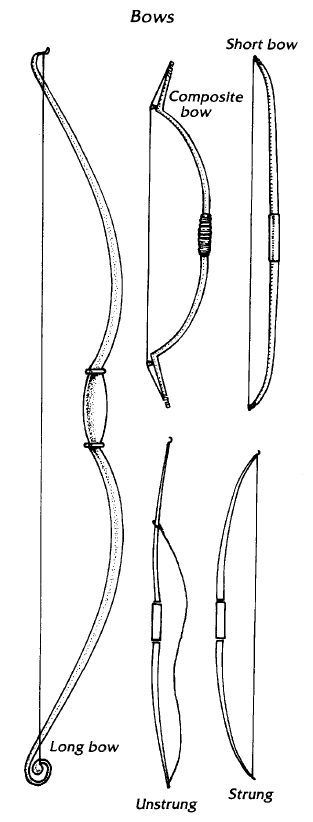
In one form or another, bows have been used since the early days of man. They represented a great step in man's ability to cause damage, since the attacker was at a considerable range from the target, not within reach of the enemy's claws or melee weapons. The first bows were long, slender rods (also called staves) with a string of animal tendon or plant fiber.
Short Bow: Short bows were the first to be developed, although they were not called such. This is more of a default term that refers to anything which is not a long bow. Short bow staves are about 5 1/2 feet long on the average. As the years passed, attempts were made to increase bow ranges. Bows were either given longer staves or flexibility was increased with no change to the length. The former resulted in what is now called the long bow. Bows fell into decline with the spread of handguns. It was reasoned that while a wounded or weakened soldier might lack the strength to pull a bow, he could still pull a trigger. In fantasy settings, there is no danger of the bow being replaced so quickly. Short bows can fire only short bow arrows (identical to flight arrows for game terms).
Long Bow: The long bow is similar to the short bow except that the staff is about as high as the archer, usually 6 to 6112 feet. It has better range than the short bow and can fire both flight and sheaf arrows.
Composite Bows: Composite bows are long bows or short bows whose staves are made from more than one type of material. This gives greater flexibility, and thus better range. These were developed after the normal long bow. The second material that makes up a long bow may be anything from another type of wood to bone, sinew, or metal. The different materials are usually glued together. An adventurer who wishes to gain a damage bonus from high Strength when wielding a bow must purchase specially crafted bows.
Such a bow costs the normal price for a bow plus the normal price again for every bonus point desired. Thus, a warrior with 17 Strength who wants a long bow (base cost 75 gp) that gives him his + 1 bonus to damage rolls would have to pay a total of 150 gp. The same fighter with 18/00 Strength (+6 bonus to damage) would pay 525 gp. These bows can be strung and drawn only by characters of that Strength or higher. Others attempting this must make a successful bend bars/lift gates roll. Most archers protect their wrists from the snap of the bowstring by fastening a piece of horn, bone, or leather to them. Such an item is known as a bracer.
Bows were used extensively for war by the Egyptians, Babylonians, Jews, and other peoples of the eastern Mediterranean world. In ancient Greece and Rome, bows were used mainly for hunting. The Huns were the deadliest archers of all the invading barbarian peoples who attacked Rome.
Charlemagne made the bow a mandatory weapon for the "civilized" armies. At the Battle of Hastings in 1066, many historians claim that the Normans, led by William the Conqueror, beat the enemy by unleashing a rain of arrows on them. Some speculate that Harold died from an arrow through his eye. The bow used was only five feet long.
The English, learning from the lessons of Hastings, continued to refine and adapt their bows, making the staff longer and longer, copying the Welsh long bow. This became known as the English long bow within England. The long bow proved very effective, especially in the British victories at Crecy and Agincourt. In the former, British archers outshot their Genoese counterparts who were using crossbows. Just as the Italians and French gained reputations as excellent crossbowmen, the English gained a reputation for archery. In the time of Henry VIII, English law required all males to learn the use of a long bow by the time they reached their teens.
European bows were most often made of ash and yew wood. Short bows were called Continental bows, while long bows were sometimes called Welsh bows. An example of the potency of the long bow can be found in a particular historical incident. An arrow fired by a Welsh bowman is reported to have pierced a knight's leg armor, his leg, the armor on the other side of the leg, the knight's saddle, and to have finally lodged in the horse, pinning the knight to his mount. Medieval archers did not always use quivers, but rather kept their arrows tied in bunches and secured to their belts by loops. Mounted archers used quivers that were attached to the saddle.
Bows were used as late as 1807, when Russian irregulars harassed Napoleon's armies, and in World War II, when detachments of American archers were used in special actions in Asia. Even today, certain African pygmy tribes and indigenous folk of the Amazon use bows.



